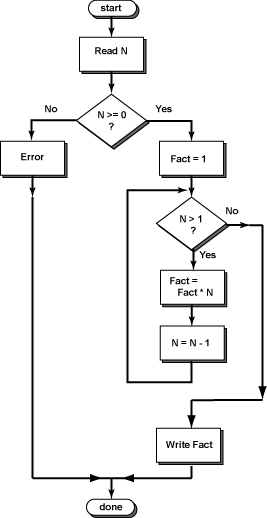Flowchart of the Program

Another way to do this is to use N as the counter, and count it down until it reaches 2, so its values are: 5, 4, 3, and 2. These values are multiplied together one by one. There is no need to multiply by 1, so the loop's condition is N > 1.
The flowchart shows how the program works. First it tests if N is positive or zero. If so, it calculates N!
N! is calculated by
first initializing Fact to 1.
Next,
a counting loop multipilies Fact
by N, then by N-1, then by N-2,
and so on down to 2.
If N starts out at 0 or at 1, then
the correct value of Fact is its initial value of one.
The loop body will not execute even once.
This program uses somewhat trickier logic than previous programs have used. Study the flowchart until you see how it works. Don't worry about the details of Java right now. The flowchart is a logic design for the program. It would work for any language.